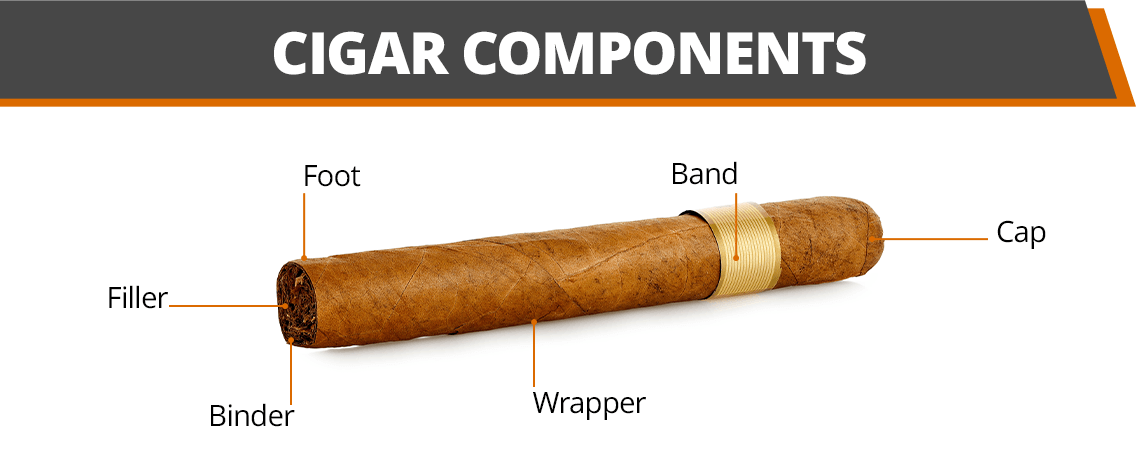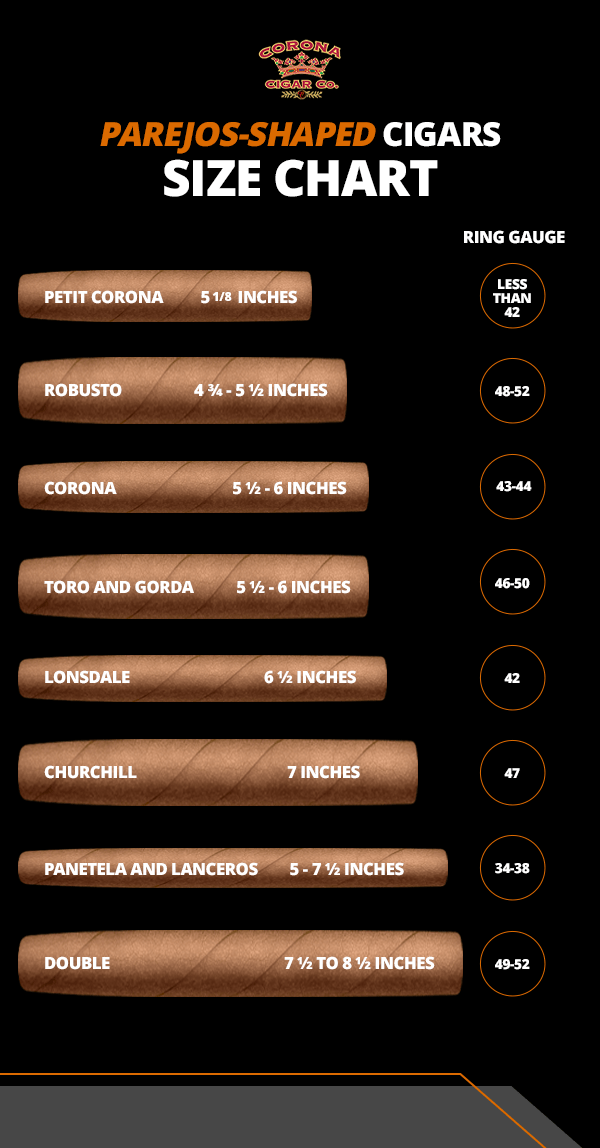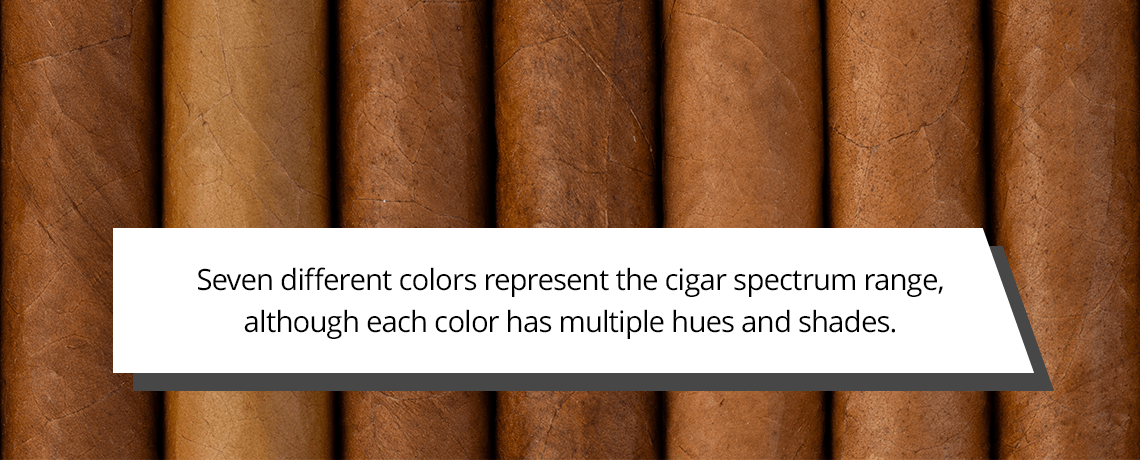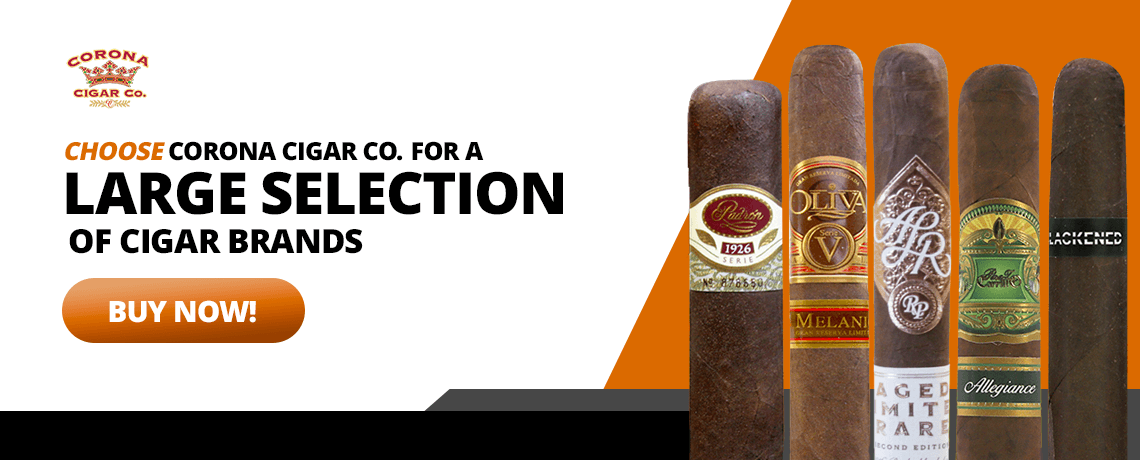The Different Types of Cigars (And Size Chart)
Jan 16 2024
Different Types of Cigars (And Size Chart)
Cigars have long been associated with prestige and luxury despite their humble beginnings in the early 1800s. Whether you're a cigar enthusiast or interested in exploring the world of cigars, there's a cigar type for everyone.
Learn more about the different cigar types, sizes, shapes, colors and other characteristics that make each unique.
Main Cigar Categories
Cigars are categorized based on how they are made. We've listed three categories below:
- Premium hand-rolled: The tobacco in premium hand-rolled cigars is of superior quality and made with outstanding craftsmanship. Expect to pay more for these handmade selections.
- Machine-made: Mass-produced using specialized automated equipment, these cigars are less expensive but no less superior in quality.
- Cigarillos: Also machine-made, cigarillos are smaller cigar counterparts that don't provide a long-lasting smoking experience. However, they do boast more flavor varieties.
The rolling method impacts the smoking experience. Hand-rolled cigars are soft and smooth and provide a better taste because of their substantially high quality. Machine-rolled cigars are tight, compact and more affordable for enthusiasts or beginners, although connoisseurs generally prefer better quality. Regardless of the rolling method, each cigar has a distinct flavor and taste profile that makes it unique.
Tobacco Characteristics
Tobacco is characterized by its flavor, body and strength. Where it's produced and how it's farmed, cultivated and curated are all factors that account for its attributes. The cigar-making process is summarized below, but it may differ between manufacturers:
- In most nurseries, tobacco seeds are covered by cheesecloth to keep them moist and protected. This provides the perfect environment for the seedlings to grow.
- Individual tobacco plants are transferred to a vast field for harvesting.
- The harvested tobacco crops are hung in curing barns in extremely humid and moist conditions. The curing process lasts roughly four to five weeks but varies depending on the desired flavor profile.
- After curation, the tobacco leaves are sorted based on their purpose as a wrapper, filler or binder.
- Each leaf is rehydrated to remove its organic nutrients and then fermented to enhance the natural taste of tobacco.
- The next process comprises bunching and rolling the leaves into cigars after placing them in molds for shaping and sizing.
- Every cigar undergoes quality control testing to ensure it meets the highest standards.
- Once the cigars are checked for imperfections and approved, they're kept in an aging room for at least three months to blend the layers of flavors.
- The second-to-last step involves checking for post-aging impurities with one more quality control test.
- After round-pressing or boxing-pressing the cigars, they are banded with the manufacturer's signature label to signify their high quality and craftsmanship.
Cigar Components
The cigar is comprised of a filler, binder and wrapper. Each leaf is harvested to be used as a layer in one of the following:
- Filler: Found inside the cigar, the filler provides the taste and aroma when smoking. It is essentially the heart of the cigar.
- Binder: The binder is the layer between the filler and wrapper, sealing and reinforcing the cigar's strength and flavor. It maintains the cigar's structural integrity and helps shape it.
- Wrapper: The outer layer has a distinct color that characterizes the cigar's look and feel. The wrapper should be attractive, as it's considered the main selling point of cigar brands.
Other cigar components include:
- Foot: The end section that's lit is known as the cigar's foot. It is either flat or tapered to obtain different flavor profiles.
- Cap: The cap is what you smoke from, and it's also called the head of the cigar. The cap is cut at an angle and affects the airflow when smoking. Experiment with different cigar cuts to achieve several outcomes.
- Band: Not an inherent part of the cigar, the band acts as an identifier that depicts a specific brand. It is wrapped around the body and contains the company name, logo and other details that help classify the cigar based on quality and reputation.
Many suggest that using the appropriate lighter — like a torch lighter — offers a smoother smoking experience when lighting the foot than normal lighters.

Wrapper Leaf Varieties
The leaf wrappers bind the tobacco, enhancing the taste by imparting their own distinct flavor profiles. Like cigars, the wrappers are sourced from different countries and boast uniqueness in color, thickness, curation, texture and smell.
The common wrapper leaf varieties are listed below:
- Maduro: Darkest in color, the Maduro wrapper is rich and sweet-flavored.
- Corojo: This Honduran wrapper is considered tough to smoke yet peppery and spicy in flavor.
- Connecticut: Locally produced in Connecticut, this wrapper is one of the smoothest and most mild-flavored.
- Cameroon: Grown in Central Africa, the distinctly rich flavors of this wrapper may be an acquired taste for some, especially beginners.
- Sumatra: Indonesian-based, the mild, sweet, versatile and balanced flavors make these wrappers a favored choice among cigar smokers.
- Habano: Nicaragua-grown with Cuban seeds, the Habano wrapper is spicy and full-body flavored. The profile may be too strong for beginners exploring cigars.
Cigar Shapes and Sizes
A cigar is measured by its length in inches and its diameter, or ring gauge. The ring gauge is the diameter broken up into 64ths of an inch. To convert ring gauge to inches, divide the ring gauge by 64. For example, a 34 ring gauge means the cigar measures about ½ inch in diameter because 34 divided by 64 is 0.53.
The size of a cigar doesn't relate to its strength, as thicker cigars are often mild, while thin cigars sometimes boast robust and stronger flavor profiles.
Cigars come in numerous shapes and sizes. We've listed the popular ones below.
1. Parejos Shape
Parejos-shaped cigars are the most common, and their sizes vary from short to long. These cigars have flat sides and round heads, and they usually require cutting before being lit at the open foot. They are typically rounded or box-pressed.
Box-pressing helps tightly secure the wrapper, filler and binder and gives the smoker a smoother "feel” when pursed between their lips. Bigger ring gauge cigars are ideally box-pressed to create the illusion that they're not as bulky, although box-pressing does not actually change the ring gauge.
A few cigars fall into the parejos category. We'll look into them in this cigar size chart.

| Corona Cigars | Corona cigars are the standard — most other cigars are compared to the size of coronas. Usually, they're around 5 ½ or 6 inches long, and their ring gauge is often between 43 AND 44. |
|---|---|
| Petit Corona Cigars | Petit coronas are a bit smaller, with a shorter length and a ring gauge of less than 42. |
| Toro and Corona Gorda Cigars | Toro and corona gorda are used interchangeably to describe this size. They're usually 5 ½ to 6 inches with a ring gauge of 46-50. |
| Double Corona Cigars | While not literally double the size of regular coronas, double coronas are typically 7 ½ to 8 ½ inches long with a 49-52 ring gauge. |
| Lonsdale Cigars | Lonsdale cigars are slightly longer and thinner than the corona. A 6 ½ inch length with a 42 ring gauge is common. |
| Robusto Cigars | Many cigar smokers enjoy this size because it is short, fat and flavorful. Robusto cigars are usually 4 ¾ to 5 ½ inches in length and have a ring gauge of 48-52. |
| Churchill Cigars | Sir Winston Churchill was fond of this size cigar, though it's not the only cigar he enjoyed — contrary to the popular legend. Churchill cigars are 7 inches long with a ring gauge of 47. This cigar is often enjoyed while unwinding after dinner. |
| Panetela and Lanceros Cigars | Panetela and Lancerno cigars are long and thin, measuring between 5 and 7 ½ inches. The ring gauge varies between 34 and 38. |
2. Figurados Shape
Parejos-shaped cigars are more common, but other shapes are gaining popularity for their uniqueness. Figurados-shaped cigars, for example, are not flat-bodied like parejos and contain different flavor profiles. They are also rounded or box-pressed.
| Pyramid Cigars | These cigars have cut feet and tapered heads, measuring between 6 and 7 inches. The ring gauge of the foot measures between 52 and 54. These cigars provide lengthier smoking experiences. |
|---|---|
| Belicoso Cigars | These pyramid-style cigars are short with rounded heads. They measure between 5 and 5 ½ inches with a 50 ring gauge. |
| Perfecto Cigars | Characterized by a closed, tapered foot and head, perfectos are thick in the middle. They can be 4 to 9 inches long with a 38-48 ring gauge. The shape varies — some resemble a bomb while others are less uniform. |
| Torpedo Cigars | The torpedo has a long, straight body with a pointed head and comes in various shapes and sizes for new or experienced smokers to enjoy. |
| Culebra Cigars | The Culebra combines three interwoven panetelas. Each cigar is about 5-6 inches long with a ring gauge of 38. These rare cigars offer more value for your money, although the overall price may be relatively higher. |
| Diadema Cigars | Diademas can be more than 8 inches long. Both ends are tapered, and their ring gauge can be as large as 60. |
Cigar Colors
The color reveals a lot about a cigar. Seven different colors represent the cigar spectrum range, although each color has multiple hues and shades. They each represent varying degrees of smoothness and sport blemish-free outer wrapping layers.

The rehydration and fermentation processes impact the color when the leaf's natural nutrients are extracted. The darker the cigar, the longer it's fermented. The lighter the cigar, the less time it's fermented.
Another factor is the amount of sunlight or shade the leaves are exposed to. Colors may be as light as light green or as dark as dark brown or black. Darker doesn't necessarily mean the cigar is stronger, and vice versa.
Check out this chart for more on the different cigar colors.
| Candela or Double Claro | These wrappers are characterized by their pale green color. The color is achieved using heat that dries and locks in the tobacco leaf's green chlorophyll. |
|---|---|
| Claro | Leaning toward a light tan color, this wrapper gets its color by growing in shade more than sunlight. They are kept under cheesecloth and air-dried. |
| Colorado Claro | These wraps turn reddish-brown due to leaves being constantly exposed to direct sunlight. They are left for lengthy periods before being harvested. |
| Colorado | Mostly grown in the shade, these wrappers are identified by their medium-brown to brownish-red color. They are pleasant to smell and burst with full-bodied flavor. |
| Maduro | These wrappers are nearly black because the tobacco undergoes a lengthy curation process. |
| Colorado Maduro | This wrapper shade falls between colorado and maduro. It's not as dark as maduro but is darker than colorado. |
| Oscuro or Double Maduro | Even darker than maduro, these wrappers are practically pitch black in color. The leaves are left to mature and cure for as long as possible, and the fermentation process takes exceptionally long. |
Choosing a Cigar
What you enjoy is determined by your personal choices and preferences. Brands are not unanimous in flavor profiles — the same cigar manufactured by one brand could taste completely different when made by another. Here are some factors that may influence your decision:
- Occasion: The occasion may dictate the cigar type you choose. Medium-bodied cigars are often preferred in more social, relaxed social settings like birthday parties or sports events where fellow cigar smokers are likely to join.
- Flavor: Your flavor preferences also impact the cigar type you choose. Many smokers opt for longer, stronger, fuller and more flavorful cigars.
- Time: Also, consider how much time you have. Cigars with a larger ring gauge typically last longer, so if you're looking to spend quality time with friends and family while smoking a high-quality cigar, you may want to choose one with a larger ring gauge. Pacing your smoking further influences the time you spend smoking. Some people smoke fast, while others prefer to take their time and savor every puff.
- Smoking conditions: The number of people around also impacts the cigar you choose. For example, light-bodied cigars emit a lighter aroma for those around, making them ideal for larger gatherings like weddings and parties since you don't want to overwhelm others with heavy fragrances.
Choose Corona Cigar Co. for a Large Selection of Cigar Brands
We've explored some of the main characteristics of cigars, including the various cigar sizes and names, shapes, components and characteristics that make each stand out in a league of its own. If you're a beginner, you may have learned terms to help navigate the fascinating world of cigars. Those experienced cigar connoisseurs out there may have gained better insight into various elements.
Whatever your preference, Corona Cigar Co. has an impressive selection of cigar bundles, five-packs, gift sets, samplers and tins. Our flavored, limited and new cigar ranges will pique new and experienced smokers' interests, and our cigar deals can introduce you to exciting products from great brands!
Browse and order a free copy of our Corona Cigar Catalog, or explore our cigars online today!


